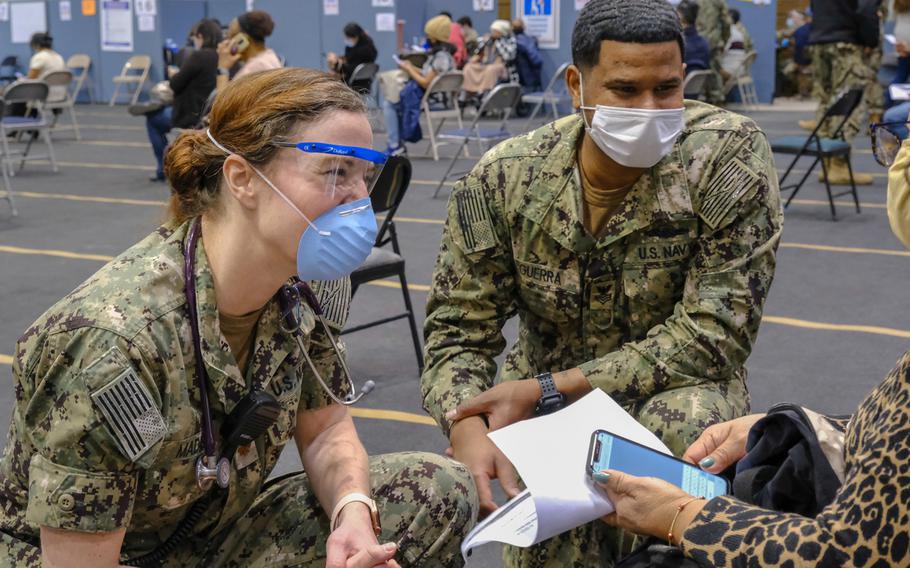
U.S. Navy Lt. Cmdr. Betsy Madison, left, a Boston native and a medical doctor assigned to Fort Belvoir Community Hospital, and U.S. Navy Boatswain Mate 1st Class Jean Guerra, a New York City native assigned to Mobile Diving and Salvage Unit 2, Joint Expeditionary Base Little Creek, Virginia, speak with a community member at the state-run, federally-supported Community Vaccination Center at York College in Brooklyn, New York, on March 10, 2021. (Robert O’Steen/U.S. Navy)
Stars and Stripes is making stories on the coronavirus pandemic available free of charge. See more staff and wire stories here. Sign up for our daily coronavirus newsletter here. Please support our journalism with a subscription.
LITTLE CREEK, Va. (Tribune News Service) — After 13 weeks in New York City’s medically-underserved Jamaica neighborhood, the Little Creek-based sailors from Mobile Diving and Salvage Unit 2 and Explosive Ordnance Disposal Group 2, like the Navy medical team they supported, came to feel a part of the community.
Now, however, they’re coming home. They turned the vaccination site they set up back to New York state authorities on Tuesday.
Their mission, vaccinating people in a part of New York hard hit by COVID-19 and where demand for vaccines was outstripping local resources, is accomplished, now that there’s less of a vaccination rush in the city.
All in all, the 139-strong Navy team — 48 from the two Little Creek units along with medical personnel from eight different commands, including Portsmouth Naval Medical Center — vaccinated some 225,000 people.
They’ve seen case counts in the Jamaica area fall. Hospitalizations of area residents for COVID-19 declined roughly 80%, deaths are down 75% and their vaccination center is big part of the reason why, said Capt. Eva Domotorffy, who led the 91 Navy nurses, hospital corpsmen and pharmacists who administered the shots.
As one of the first military groups dispatched to set up a 3,000-shots-a-day vaccination center for the Federal Emergency Management Agency, they pioneered some basic operating guidelines, ultimately in the form of a 40-page lessons learned document, said Cmdr. Trevor Ritland, the MDSU commanding officer who served as site commander.
They arrived on Feb. 20 and 21 — and were getting shots in arms on Feb. 23, even though some supplies, including sanitation pads, hadn’t arrived yet.
“Everyone pitched in, we were there with FEMA, state people — they figured out who could help, we all started calling around. Local hospitals sent over supplies, we went out to local stores, and when it was time to open the doors, we were ready,” Ritland said.
Working with FEMA and the state, his sailors figured out the best way to set up the site, which was in the college gym. Their job was support — everything from setting up to handling registrations and tracking patients to helping wheelchair-bound patients get around.
Domotorffy’s medical team had to figure out a way to handle the vaccine in a gym that had no facilities for a vaccine that arrived frozen and had to be refrigerated until shortly before the pharmacists drew the precise doses required. They ended up taking over a classroom and created a sterile processing center from scratch.
One early challenge was work schedules — the original idea of operating two eight-hour shifts wasn’t going to work for the 3,000-shots-a-day, seven-day-a-week target.
The answer — it’s there in that 40-page lessons learned document — was a three-days-on, one-day-off schedule with 11- to 12-hour shifts. Eventually, they moved to a two-days-on, one-day-off schedule. They hit that 3,000-shots-a-day target. And they didn’t miss a day — not even Easter Sunday.
The schedule innovation gave the team time to take care of themselves, Domotoroffy said.
Staying in nearby hotels, “we’d be out in the neighborhood for shopping, to get something to eat,” she said. “By the end of the 13 weeks, we were feeling like we’re becoming part of the community. ...
“We helped people, elderly people who hadn’t been out of their homes more than a handful of times, people who couldn’t get to work,” she said.
There was no question about vaccine hesitancy, either. Ritland said. Every appointment slot was filled — it wasn’t until the last few weeks, when his sailors would call to make sure people who missed an appointment were OK, that it became clear that the rush was easing.
“You could get shots at the pharmacy five minutes away, instead of driving 25 minutes here — that’s what we kept hearing,” he said.
Supporting a vaccination center was something new for his sailors — a somewhat unsettling break from the daily focus on training that’s part of life for Navy divers, Ritlin said.
“But when we talked to them, we said: This is the nation’s No. 1 priority, this is an emergency, fighting this virus. ... This is what the nation needs us to do, and that’s what we’ve all signed up for,” he said.
“When people wonder what Navy divers are doing providing support to a community vaccination center, we’re prepared to be surge ready, surge ready to head out. We’re certified to do command and control in an expeditionary mission,” he said. “This was new, but we were proud to be part of it.”
©2021 Daily Press
Visit www.dailypress.com.
Distributed by Tribune Content Agency, LLC.